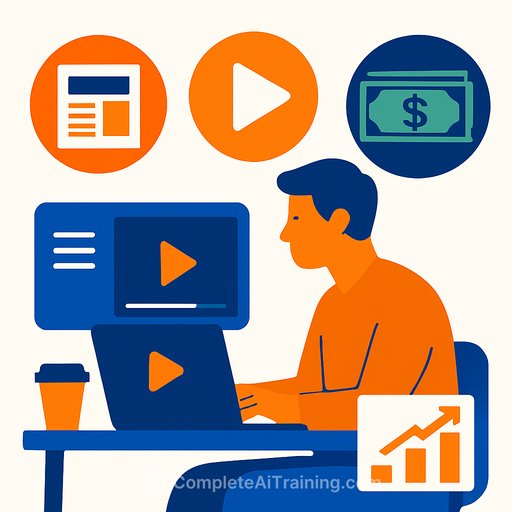Inside The Economist's plan to grow revenue in a post-search, AI-first future
AI assistants are fast becoming the default place people ask questions. That puts every publisher - and every brand - at risk of commoditized answers and lost direct relationships.
The Economist's response is clear: double down on formats that are hard to mimic, protect core IP from LLMs, rebuild direct audience pipes, and bring advertising back to the center. The aim is simple: stay essential, stay direct, and stay monetizable.
Why this matters for marketers
- Distribution is shifting from search to AI assistants. Your brand needs new entry points that don't rely on blue links.
- Formats with real human interaction (debates, live video, Q&A) resist commoditization and create premium ad inventory.
- First-party data beats borrowed reach. Registered users and subscribers will carry your growth.
- AI platforms may be better as billboards than traffic sources - for now.
Bet 1: Video that AI can't easily replace
The Economist is launching Insider on Oct. 9: long-form, debate-led video featuring its senior editors in conversation with leaders and policy makers. Two shows per week, 30-60 minutes each, across four themes: defence, geopolitics, economics, and tech.
It's a small but meaningful shift from the publication's traditional anonymity: editors on camera, interactive Q&As, and a front-row seat to the newsroom's thinking. The format fits the brand - depth over personality cults - which keeps credibility intact while giving subscribers more access.
It also opens fresh, high-value inventory. Anthropic's Claude AI is the launch sponsor. For marketers, that's a signal: long-form expert programming is back in demand - and it's priced accordingly. Claude AI is betting on it.
Bet 2: Hold the line on LLM licensing
Unlike peers striking content deals, The Economist is keeping its journalism off-limits, blocking AI bots through Cloudflare and planning for zero referral traffic from AI platforms. The logic: these products aim to be destinations, not gateways.
They may allow top stories to appear on AI platforms for brand visibility, but with strict control over crawlers and no expectation of clicks or revenue. Treat AI endpoints like rented billboards - useful for awareness, not conversion.
Bet 3: Build in-house AI that increases stickiness
The company launched an AI Lab in the spring to create new subscriber experiences. A current prototype is a ring-fenced, on-site LLM that lets readers query articles via a prompt chatbot, pulling from the archive and journalist expertise to clarify pro/con arguments.
They're also testing content formats across modes and lengths: five-minute summaries, 50-minute deep dives, text, video, and audio. The goal is simple: meet subscriber intent, increase time spent, and make the product harder to replace.
Bet 4: Rebuild the top of funnel without search
With ~70 million social followers, the focus is converting those audiences into registered users - email first, no password friction - and nurturing them into paid. Expect a series of incentives tied to limited free access and value-led onboarding.
The Economist is also testing niche growth via a new Substack newsletter. The aim is to build fresh communities around topics adjacent to (but not central to) the core bundle, expanding reach without cannibalizing the main subscription.
Advertising makes a comeback
Even with 1.25 million subscribers (up 3% YoY) and a strong digital base (+8% YoY), insulation isn't immunity. The plan puts more emphasis on advertising, using premium video and expert programming to create inventory brands actually want.
Long-form debates and editorial access are tough for LLMs to summarize away, which makes them defensible and valuable. That's where ad dollars will flow.
Metrics snapshot
- Subscribers: 1.25 million (+3% YoY); digital subs +8% YoY
- Revenue: £368.5 million ($497.4 million) for the 12 months ending March
- Focus areas: video, first-party data growth, in-house AI products, premium ad inventory
What marketers can apply now
- Shift budget to expert-led, conversation-heavy formats that resist summarization.
- Start a "registered user" program: email-first access, frictionless sign-up, progressive profiling.
- Treat AI platforms as reach channels, not conversion engines. Measure awareness lift, not clicks.
- Build interactive experiences on your owned properties: guided Q&As, explainers, debate formats.
- Balance subscriptions with ad-driven products. Premium video can subsidize depth.
- Make editors and subject-matter experts the face of the brand - without turning them into influencers.
Risks to watch
- Licensing short-term wins that weaken your moat.
- Over-indexing on personality content that doesn't fit your brand.
- Relying on social reach without clear paths to registration and email.
- Building features without clear KPIs: time spent, retention, and ad yield should guide the roadmap.
Useful links
Level up your AI marketing skills
If you're planning your own post-search strategy, upskill your team on AI tools and workflows for acquisition and retention. Start with this resource: AI Certification for Marketing Specialists.
Your membership also unlocks:






